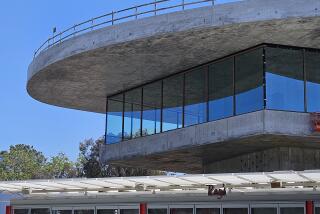ANCIENT WEST MEXICO WORKS : COUNTY ART MUSEUM BUYS SCULPTURE CACHE
The County Museum of Art announced the purchase today of a private collection of ancient sculpture from west Mexico that makes it the leading U.S. repository for such art, according to museum Director Earl A. Powell III.
The trove is a legendary holding of 235 ceramic sculptures and vessels amassed by Proctor Stafford, a museum trustee and collector noted for possessing a keen eye for artistic quality in primitive art.
“What makes this collection so special is its aesthetic superiority,” Powell said. “Proctor’s instincts are those of a connoisseur rather than of an archeologist and that shows in his selections. You don’t have to know anything about this particular field to recognize that these works are just great pieces of sculpture.” He pointed out such rarities as a hunchback figure Stafford calls his “Mona Lisa.”
Powell refused to divulge the purchase price, following museum policy, but educated guesses peg it somewhat under $2 million. About 50 prime works from the collection are scheduled to go on view at the end of January.
West Mexican art, like much ancient art, is shrouded in mystery. It was made in the lands along the Pacific Ocean that are today the states of Colima, Nayarit and Jalisco. It consists mainly of clay vessels and of hollow figures that often have chunky, flattened bodies, large noses and thick legs. Objects range in size from toylike cookie-cutter figures arranged in groups to a three-foot tall “King” that is considered monumental for the genre.
Stafford’s collection was shown at the museum in 1970, where it drew critical acclaim. The exhibition’s out-of-print catalogue has become a virtually definitive work in the field. The art dates from 150 BC to AD 200 and characteristically depicts daily life, with overtones ranging from the magical to the macabre and humorous. There are wrestlers, jugglers, musicians, shamans, dancers, merchants and rulers. Compared to the courtly and ritual styles of Mayan and Aztec cultures, West Mexican art is often seen as a kind of populist genre art.
“Archeologists love it because they can learn so much about the customs of the people,” said Tina Oldknow, the museum’s associate curator of ancient art. She pointed out details of clothing and artifacts that tally with surviving examples, such as typical necklace pendants. Although extremely stylized, figures even have such medical detail that one is covered in a pattern of flower-like markings scholars believe to represent syphilitic pox.
“When you add this work to our (Constance) Fearing collection with its wonderful spread of characteristic examples, then there are two places to go for West Mexican Pre-Columbianart--the museums here in L.A. and, of course the archeological museum in Mexico City (National Museum of Archeology),” Oldknow said.
She explained that the Stafford collection offers particular advantages to a museum because it was largely amassed between the 1940s and early 1960s before Mexico instituted tougher laws against the export of material considered part of its cultural patrimony.
Thus, for both aesthetic and practical reasons, the Stafford collection would be virtually impossible to duplicate today and comes to the museum with a clean bill of health as to the legal title of the acquisition, according to Oldknow.
Powell acknowledged that the three years of negotiation with the collector were among the most protracted in his experience and had broken off several times because the museum could not find the funds to make the acquisition. “Recently our Balch Fund (an acquisitions endowment fund) was freed up after we paid off the Heeramaneck collection (of ancient Near Eastern art), so we were finally able to do it. I’m delighted. This is like a Norton Simon collection of Pre-Columbian art. Look at that figure; it looks modern.”
More to Read
The biggest entertainment stories
Get our big stories about Hollywood, film, television, music, arts, culture and more right in your inbox as soon as they publish.
You may occasionally receive promotional content from the Los Angeles Times.










